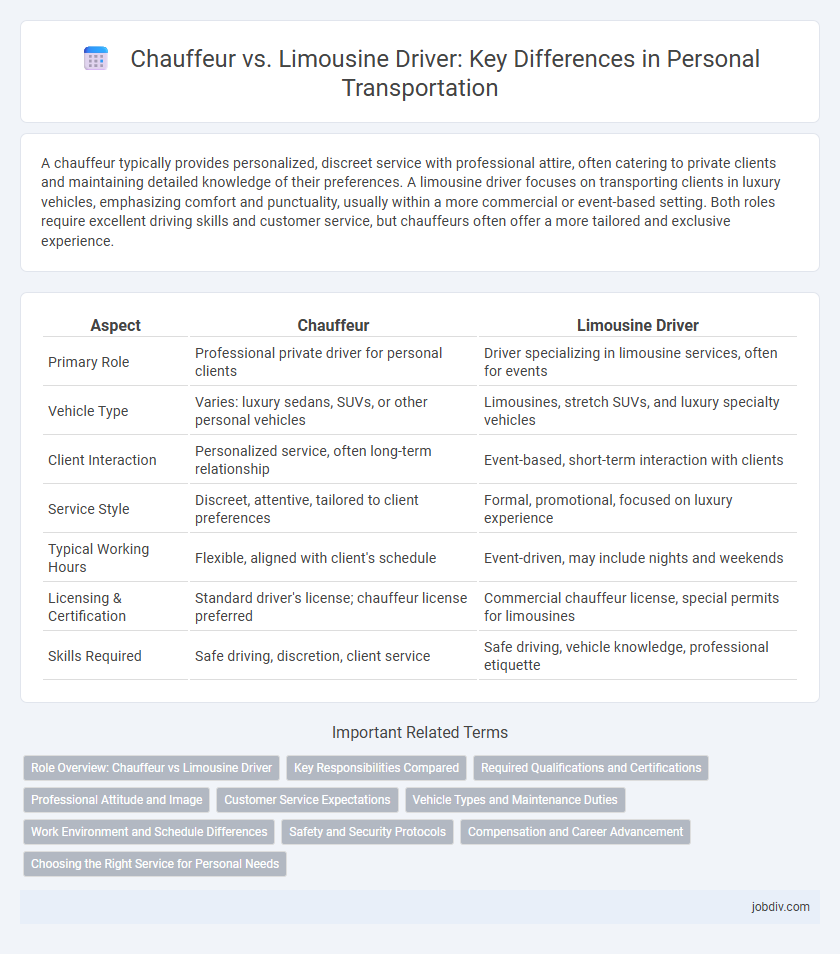A chauffeur typically provides personalized, discreet service with professional attire, often catering to private clients and maintaining detailed knowledge of their preferences. A limousine driver focuses on transporting clients in luxury vehicles, emphasizing comfort and punctuality, usually within a more commercial or event-based setting. Both roles require excellent driving skills and customer service, but chauffeurs often offer a more tailored and exclusive experience.
Table of Comparison
| Aspect | Chauffeur | Limousine Driver |
|---|---|---|
| Primary Role | Professional private driver for personal clients | Driver specializing in limousine services, often for events |
| Vehicle Type | Varies: luxury sedans, SUVs, or other personal vehicles | Limousines, stretch SUVs, and luxury specialty vehicles |
| Client Interaction | Personalized service, often long-term relationship | Event-based, short-term interaction with clients |
| Service Style | Discreet, attentive, tailored to client preferences | Formal, promotional, focused on luxury experience |
| Typical Working Hours | Flexible, aligned with client's schedule | Event-driven, may include nights and weekends |
| Licensing & Certification | Standard driver's license; chauffeur license preferred | Commercial chauffeur license, special permits for limousines |
| Skills Required | Safe driving, discretion, client service | Safe driving, vehicle knowledge, professional etiquette |
Role Overview: Chauffeur vs Limousine Driver
A chauffeur primarily focuses on providing personalized, professional driving services often including vehicle maintenance and client assistance, ensuring a fully tailored experience. Limousine drivers specialize in transporting clients in luxury vehicles, emphasizing punctuality, discretion, and comfort during special events or corporate occasions. Both roles require strong driving skills and customer service, but chauffeurs often engage in more detailed client interaction and vehicle care.
Key Responsibilities Compared
Chauffeurs primarily focus on providing personalized, professional driving services, ensuring passenger comfort, and maintaining vehicle cleanliness and readiness. Limousine drivers typically emphasize luxury experiences, managing route planning for events and client schedules, and adhering to strict punctuality standards. Both roles require excellent driving skills and customer service, but chauffeurs often cater to private clients while limousine drivers serve event-based or corporate clientele.
Required Qualifications and Certifications
Chauffeurs typically require a valid driver's license, a clean driving record, and often a special chauffeur's license or endorsement depending on local regulations, along with strong customer service skills. Limousine drivers usually need a commercial driver's license (CDL) or a specific limousine driver permit, in addition to completed training in vehicle safety, professional driving techniques, and knowledge of traffic laws. Both roles often demand background checks, defensive driving certifications, and first aid training to ensure passenger safety and service quality.
Professional Attitude and Image
Chauffeurs project a polished, professional image with tailored uniforms and a strong emphasis on etiquette, ensuring clients feel respected and secure. Limousine drivers prioritize punctuality and discreet service, maintaining a clean, well-managed vehicle that reflects luxury and reliability. Both roles demand exceptional interpersonal skills and strict adherence to confidentiality, setting high standards for professionalism in personal transportation.
Customer Service Expectations
Chauffeurs are expected to provide personalized, high-end customer service, including knowledge of luxury vehicles, professional attire, and a courteous, discreet demeanor. Limousine drivers primarily focus on safe transportation and timely arrivals, often handling multiple passengers with efficiency and basic client interaction. Both roles require excellent driving skills, but chauffeur services emphasize creating a bespoke, comfortable experience tailored to individual client preferences.
Vehicle Types and Maintenance Duties
Chauffeurs typically operate luxury sedans such as Mercedes-Benz S-Class or BMW 7 Series, focusing on meticulous vehicle upkeep including regular cleaning and mechanical inspections to ensure a smooth, high-end ride. Limousine drivers usually handle stretch limousines like Lincoln Town Cars or Cadillac Escalades, with maintenance duties emphasizing both interior amenities and exterior appearance to maintain passenger comfort and style. Both roles require attention to detail in vehicle maintenance but differ in the type of vehicles managed and specific care routines.
Work Environment and Schedule Differences
Chauffeurs typically work in private households or for individual clients, offering personalized transportation services with flexible hours that may include evenings and weekends. Limousine drivers often operate within commercial fleets, servicing events and corporate clients under scheduled shifts that can involve long hours and last-minute changes. The chauffeur's work environment tends to be more private and exclusive, while limousine drivers frequently navigate public venues and event locations with a higher degree of unpredictability in their daily routines.
Safety and Security Protocols
Chauffeurs adhere to strict safety and security protocols, including thorough background checks, advanced defensive driving training, and comprehensive knowledge of emergency procedures to ensure passenger protection. Limousine drivers must comply with regulatory requirements, but may not receive the same level of specialized training or personalized security measures as professional chauffeurs. Both roles prioritize passenger safety, yet chauffeurs typically offer enhanced vigilance and tailored security protocols for high-profile clientele.
Compensation and Career Advancement
Chauffeurs typically earn a median hourly wage of $18 to $22, while limousine drivers can command higher rates, often between $25 and $35 per hour, reflecting the premium service they provide. Career advancement for chauffeurs often involves progressing to private or executive driving roles, whereas limousine drivers can advance to managing fleet operations or securing contracts with luxury transportation companies. Experience, impeccable customer service, and specialized certifications significantly enhance compensation and open pathways for career growth in both professions.
Choosing the Right Service for Personal Needs
Choosing between a chauffeur and a limousine driver depends on your specific personal needs, such as the level of service, vehicle type, and occasion. Chauffeurs often provide a more personalized experience with professional etiquette, door-to-door assistance, and intimate knowledge of routes, ideal for business or luxury travel. Limousine drivers typically focus on passenger transportation with luxury vehicles for events like weddings or parties, making the choice dependent on whether you prioritize personalized service or event-focused transportation.
Chauffeur vs Limousine Driver Infographic

 jobdiv.com
jobdiv.com